Most of us have been there, some projects just don’t get finished. Everyone shelves an in-progress build from time to time, and some hackers drop almost every project for fully finishing it. Why does it happen? What can we do about it? Or does it even matter? My own most memorable one is the wine glass rack I was making for my sister’s birthday, still sitting incomplete on a shelf eleven years later.
The answer may lie in what you consider to be a “done” project. Is it a fully completed build with every possible feature implemented and polished? With that rubric you could be counting all of your completed projects on one hand. What are you really getting out of your personal projects? It’s an interesting topic to consider as pivoting your mindset can end up boosting your productivity. So let’s dig in!
Kid In A Candy Store Syndrome
 I have a friend who is a very hard worker and capable of taking on any challenge he chooses. A while back he fell into a pattern. He’d start a project, then another, and another. Anything was fair game. But with a limited amount of time per day, nothing was getting finished. Instead, smaller and smaller amounts of time were available for each project. To take on another, he had to first drop one.
I have a friend who is a very hard worker and capable of taking on any challenge he chooses. A while back he fell into a pattern. He’d start a project, then another, and another. Anything was fair game. But with a limited amount of time per day, nothing was getting finished. Instead, smaller and smaller amounts of time were available for each project. To take on another, he had to first drop one.
Talking to him about it one day, I realized he was like a kid in a candy store. The kid sees one tempting treat and grabs it, then another. Pretty soon his hands are full and taking one more only causes him to drop another.
It doesn’t help that the selection of tasties is endless. Until the kid realizes his problem he’d never leave the store. Which is the same as saying that my friend would keep dropping projects to take on more, never finishing any.
Doing Only The Interesting Parts
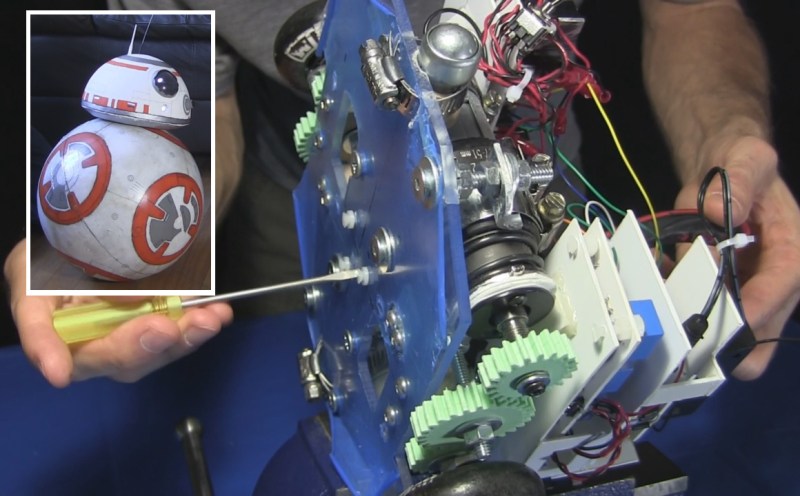
Our eyes are naturally drawn to the project that has something interesting in it. The BB-8 droid — that cute ball-shaped robot from Star Wars — is a perfect example. Its body is essentially a smooth ball which moves by rolling along, yet no matter which direction it rolls in, the head stays on. The instant I saw BB-8 rolling along at high speed in the first Star Wars: The Force Awakens trailer, I was hooked.
But let’s boil this down: I didn’t see a Star Wars droid. I saw a very interesting engineering challenge. How to make it roll? How to keep the head on? The answers were simple but making it work was not. It was a very tasty treat.
My BB-8 droid works well now and has delighted many a youngster and adult alike at a variety of events. But it remains unfinished. I’ve yet to add sound effects or to make it move faster which is just a boring power issue easily solved with money. The interesting parts are all done and I’ve moved on. Maybe I’ll get back to it when some time opens up in this endless candy store.
The point is that I learned a lot of mechanical engineering concepts, and I saw success in the process. My personal growth there is done, even if the actual project isn’t.
The Dreaded Ones That Get Away

Occasionally (and I hope rarely) a project just doesn’t work. It looked like a good idea but it turned out to be intractable or impossible at the time.
One such crazy idea of mine was to make something like the multi-legged, hologram projecting robot in the scene shown here from Star Wars – The Phantom Menace. I’d have a projector in the robot projecting upward to a tall, slightly tilted transparent screen. An onlooker would see the image appear in front of whatever was behind it, just like a so-called pyramid hologram, what’s really the Pepper’s ghost effect.
However, for the image to appear normal on the tall screen, the image from the projector would have to be distorted, an anamorphic projection. After some experimentation, I found that the bottom of the image would have a decent resolution but pixels near the top would too large and smeared, making the image indecipherable there. So I dropped the project. Realizing there’s an insurmountable technical hurdle before you’ve past the tipping point on a project is a lesson everyone learns to hard way so look out for it in your own work.
As for my unfinished sister’s wine glass rack, I ceased work on it when I realized my woodworking skills weren’t up to making one nice enough to display in her elegantly decorated dining room.
In both of these examples, making a calculated decision to cut your losses is key to productivity in other things. It was a wise investment to spend a lot of time learning during the BB-8 build because my skills were progressing. With fine woodworking, the learning curve was far too shallow — it would take me forever to become a master carpenter. If I need fine woodworking in the future I know I need to find a collaborator to take on that task.
Getting Lost on a Tangent
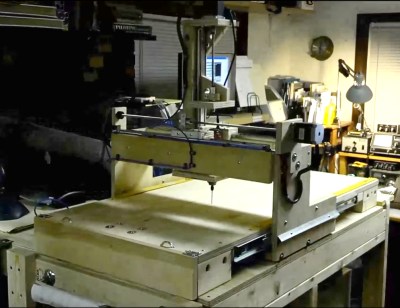
Have you ever gotten distracted with projects that were started in support of other projects? Good examples of this are making your own CNC machine, laser cutter, or 3D printer before using them to build the “real” project.
To make matters worse, you might start with a small one first, then make a bigger one. And of course, along the way you realize it can be improved upon: the CNC machine’s x and y-axes can be made smoother, the laser cutter’s laser needs to be more powerful requiring a different support mechanism, or you come up with a way to make the 3D printer’s structure sturdier. There’s always one more improvement which we can make.
The “real” project is delayed because the effort to make the tool takes up all available time and resources. But who are we kidding? Often the tool was what we really wanted to make in the first place. There’s nothing wrong with this, as long as you take a step back when taking on new builds and decide if this project fits your goals, time, and resources. As with my woodworking, should you take on a tool-building project or just outsource a bit of fabrication and get back to the project you really want to focus on?
How To Set Yourself Up for Finishing Projects
For many projects, I will simply say “I don’t do pretty”. These are the ones where I’m proving a concept or learning a skill, a polished appearance as if the thing would fit in on a store shelf just doesn’t matter. But at times, a project really does need to reach a pre-defined stage of completeness. Here are some suggestions for making sure it’ll get there.
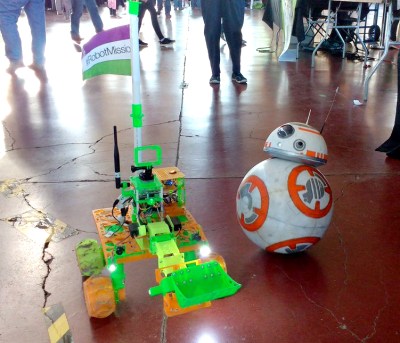
Do the less interesting, easier stuff first. For my BB-8 droid, this means first installing the LEDs and painting the ball and head. Only after finished this cosmetic stuff which I don’t find very interesting would I move on to the more interesting engineering challenges. That way, after the challenges have been met, the droid is finished. But I didn’t do it in that order, and BB-8 almost didn’t get a coat of paint. Instead, the next trick made that happen.
Make a commitment to someone, or to publishing or demonstrating it somewhere. My BB-8 got painted because I’d committed to showing it at a booth at a Maker Faire. Making that commitment to someone else really helps drive you to follow through.
Leave the project on the workbench. The saying, “out of sight is out of mind” rings true. If you need to finish something, give it the bulk of your work area and it’ll hound you to finish it.
Use wise strategies to overcome pain points. If the project is stalled due to something difficult, there are many tricks to help find the solution:
- Break it into smaller steps. The result is a set of easier problems to solve.
- Step away from it, sleep on it. Let your brain stew on it in the background. Often you’ll have an epiphany at the most unlikely times. Lying in bed in the morning or during a morning shower seem to be epiphany time for me.
- Explain it to someone. More often than not, you’ll get only part way through the explanation before the solution comes to you and you leave your audience slack-jawed, wondering where you ran off to so suddenly.
- Get someone to help you or turn it into a group project.
It’s Okay To Walk Away
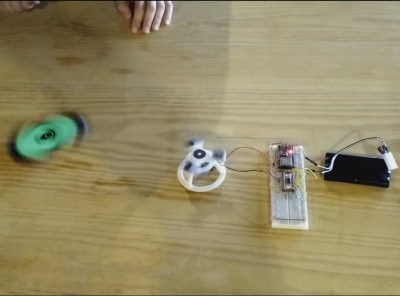 In the end, if the project matters only to you then it’s okay to leave it at whatever stage you want to. Setting too high an expectation for yourself of completing every project chains you up and may even prevent you from taking them on. Don’t fall into that trap!
In the end, if the project matters only to you then it’s okay to leave it at whatever stage you want to. Setting too high an expectation for yourself of completing every project chains you up and may even prevent you from taking them on. Don’t fall into that trap!
There are good reasons for doing projects which you don’t finish:
- Many projects involve learning new skills along the way (e.g this phone-controlled fidget spinner).
- They often involve a lot of research into pretty much anything: electronics, optics, chemistry, mechanics, and so on. The list of stuff you can learn is endless.
- They spawn new ideas for more projects.
- Abandoned projects become raw material for future projects if you don’t mind taking your old masterpieces apart.
What are your own reasons for not finishing projects? What tricks do you have for getting them done? Let us know in the comment below.
Postscript
Speaking of comments, Hackaday comment threads often lead to new articles. (Thank you!) This article was inspired by a thread begun by [Doug Leppard] under this article about an in-between project done by [James Bruton] while waiting for parts. [Doug’s] thread was spawned when he commented that his in-between projects sometimes don’t get completed. Clearly, we could all identify in some way. On reading that thread I added the article idea to my todo list. Consider this article a finished project.

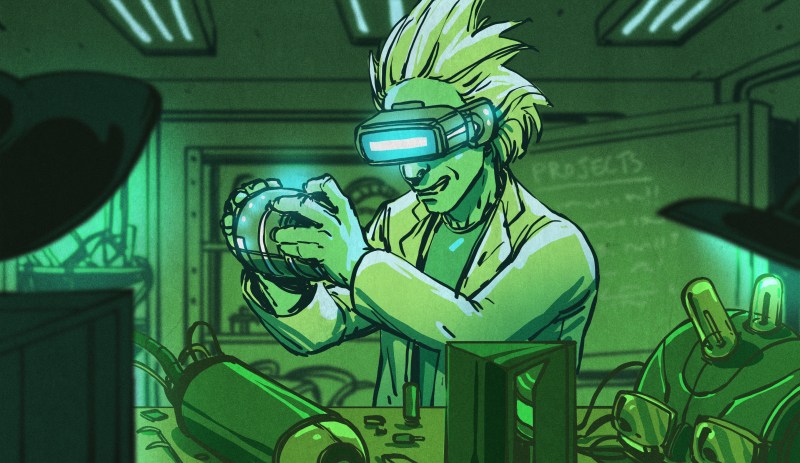














“I have a friend who…”
Ha! I recognize those words. That’s what everyone says just before they start talking about themselves!
That’s ok though.
We all have “that friend” here, am I right?
I know I certainly do.
Oh, I thought he was talking about me ;-P
Actually, I fall under the anecdote of not taking on projects because they feel too big to finish. There’s a saying when you served yourself to much food at a meal: “my eyes are bigger than my stomach”. The sentiment rings true for my appetite fro new projects.
:-) I was wondering if anyone was going to say that. Nope, the “friend” is an actual friend, not me. He’s more focused now and is firmly tied down running a solar company.
You have to break projects into smaller steps, but then it sucks, because you see that there are trillion small steps of which 99% isn’t fun and you have to do 50% of them before you get the to the first fun task. And when you get to 70% it’s working somehow and polishing is boring and that’s when the project is left for dead.
I’m definitely prone to the “it’s working, why would I bother doing more?”.
Yes. After the engineering challenges are solved the rest is often too boring for me to finish.
I forced myself to finish a recent clock project by offering to give it to someone (not even someone I knew, just a speaker at EMF camp) The design was relevant to her research project.
But it is also worth bearing in mind that a hobby is a hobby even if you are a long way from the end point.
10 years or so ago I decided to make a clock. But for that I would need a lathe. Then I decided the lathe should be CNC and include a mill, so I bought a better lathe. Then converted to CNC. Then decided the CNC software (LinuxCNC) needed improvements. So I taught myself C to make those improvements. Learning a programming language is a long way from machining brass on a lathe. But it was all fun, and all part of the hobby.
10 years on I have quite a nice CNC lathe and Mill, having also taught myself pattern-making to make the castings for new parts for the machine tools. But I am nowhere near even starting the clock….
Andy..YOU DA MAN!!! (clock not required for happiness!)
But you now have tools and the knowledge to use those tools. With a CNC lathe and mill, you can take on almost any project.
Once the main challenge of a project is finished, I often lose interest (the remainder is easy and boring, I will do it one day) … But I do manage to finish most of my projects nowadays :)
I know that. Electronics work, but putting it into a nice case is only boring (for me) mechanical work. Finish it with some duck tape :-)
All good points.
When I was a young lad of an engineer, I often mused to myself that one of my best mentors would start a lot of projects he didn’t finish. They would be scattered all over his home lab, in various states of completeness. At the time, I thought he lacked discipline.
Now that I am in my 50’s as he was, I understand it. There is only so much time. Spend it wisely, and do good things that you enjoy.
You have the point. Some times we are very amused doing something until another thing catch our attention.
The problem (or solution?) is when you do project videos on youtube. Subs will hound you till to you finish a project and will never let you forget if you dont. I personally find it difficult to complete a project once I’ve lost interest. But my interest is cyclical and often putting down a project to work on another more interesting one and then coming back in a few months works for me. The one thing that really kills any pleasure for me though is having to document everything in the heat of the moment. I’m not talking about commenting code or jotting down notes, but having a freaking camera in your damn face while you are trying to hand solder a high pin pitch qfn and trying to keep everything in frame while talking while having super precise hand coordination. I’ve recently compromised by doing overhead time lapses for those bits instead which is much less infuriating with the added benefit of shortening my videos.
We’re kindred spirits then. I have the same problem (solution) where subs hound me once I’ve said I’ll do something (rightly) but often some new idea gets me going instead. And I have the same issue recording a video, and sometimes the audio too while making something. I have to remind myself that the video is also important. I figure the problem with finishing the projects in a reasonable time there is that it takes around 5x that way. There’s scripting the shot so it fits into the narrative, preparing the area, lighting, multiple takes, checking the clips before getting to a point where there’s no going back, and retakes when you spot something on the big screen which you missed on the camera’s small screen. Sadly, time lapses don’t work with my style of content.
I dont understand why people put their stuff on youtube. Is it to show off? Or they need acceptance from others?
I enjoy watching it, but too many of them have massive ego’s that need stroking.
Look at Matthew Wandel, he’s gone off in some random direction ranting at how terrible youtube is, on youtube, and stopped making stuff.
Yes, it;s showing off :-)
Also, to a large extent, to demonstrate how to do things to other people who might want to do the same thing. A sharing of ideas.
I help develop LinuxCNC, most of my YouTube videos are demonstrating various aspects of what that can do.
There is a class of people who make a lot of money from YouTube / Patreon. They have different motivations.
But those of us with little niche amateur channels (a few hundred subscribers) are often in it for pedagogic reasons.
I’d be lying if I said it isn’t nice showing off my projects and getting comments from others acknowledging my work, but it is really just another format to spread ideas just like hackaday does with its written project posts. I have seen other channels which are all about ego and money, but for me I really just want to make ideas that pop into my head a reality and youtube ad money helps make that a reality. I also get a lot of good feedback (interspersed among the troll comments) when I screw up on how to do things better or what parts I should go with in future iterations. If I am being honest I have no idea how I got to 8K subs or why other’s would want to watch an amateur like me botch projects together but apparently they are happy and I am happy so I cant complain.
I want to thank you and others for taking the effort for posting the work you have done either in an HAD article or YouTube. It has saved me hundreds of hours in finding the best solution. I don’t care if ego drives one, I care about the information.
For me it started out from a combination of enjoying making movies and enjoying creating clear explanations for things, I’ve been a teacher in various capacities during my career. This was before youtube had ads. The projects themselves are something I’ve always done. Then when ads came along, I ramped it up. I’ve since ramped back down a bit and now do it for enjoyment again even though it makes some projects take longer, plus for the extra income it generates.
Probably not the best example, Mathias Wandel has mostly stopped making things for a bit due to physical injury and being in the middle of a long-distance move.
I will agree that the side channel he has been doing with John Heisz is not nearly as interesting as his actual projects.
So I did not yet any youtube video – and don’t know if ever.
At first documentation, fotos or even making (editing!) videos is not what I like to do. On the other hand (subs hound you) this make the project even more feel like a duty, an obligation, which takes the fun out of it.
Sometimes after the scope of the project becomes clearer and we see a fundamental issue we don’t have a resolution for, the answer to “should I finish this project” is no. It’s our stubbornness that keeps us from declaring it a failure and fully moving on. Then our failures pile up and keep us from doing other projects since we really “should” finish this project first.
Or maybe that’s just me.
Given I’m ADHD, finishing projects can be difficult anyway. That often includes home improvement projects, but at least there I have a wife that insures I get thing done.
Right now I have been working on finishing some near-completed projects. I will often do some of the easier, hardware assembly first so the project look like progress has been made. I think it gives a psychological boost to see tangible progress being made.
May I add another angle?
What do you do with *finished* projects?
I tend to have no plan on where to put the nice lamp I built and the end result is that it sits around somewhere, having no use and eating precious shelving space…
Give them away? The fun is in the making and proving out the idea. The LED filament clock that I made and that got featured here was like that. Once it was finished I gave it away to someone who seemed to want it more than I did.
I kill two birds with one stone, I give crap I made away as christmas or birthday gifts to my vict… erm I mean friends and relatives …
A lot of my potential projects die as scribbles in my notebooks when I realise that I don’t really want/need them… but then years later, if some new need or want is close to old ideas, I get it out and rework it… certainly stops piles of done and unloved projects building up. However, it does become it’s own challenge when I get a desire to learn X new thing through using it in a project, but nothing I can think of to do can find a niche or even whimsical use, it just kinda stalls learning X until something comes up.
i cant just leave projects on the bench, if i do the cats will destroy them.
i think i have 2 main projects going now, one was held up by running out of supplies (half etched pcb because i ran out of peroxide) and another is almost done, just needing me to do some light 3d design and a little bit of wiring. there are several projects on pause. like i did a wireless gamepad (with a 1km range), but it was shelved due to a firmware problem that i never got around to fixing. i have a game engine that only gets worked on periodically, i worked on it a few months ago and added some rudimentary collision detection code and put it back on hold. its unlikely it will ever get finished. some projects just get tossed into the scrap heap to be salvaged for parts at a later date.
I try to keep the cats out of the electronics room. Because especially one of them likes small PCBs with wires on them very much and I would find them destroyed and distributed over the apartment. He wants not to accept “These are my toys, not yours. And before you do not know how to use the soldering iron properly, that must not change.” :-)
The other problem is that the unfinished stuff piles up on the rear end of the bench. :-) I need to do something quickly and just shove the other stuff away. One of my big problems is: I can not throw away broken stuff which I consider repairable – but in reality mostly I just do not have the time to do it.
Well since I was quoted in or even inspired this article I thought I would comment. Steven good thoughts on completing projects. I do have lots of finished projects but do have many unfinished projects. The ones that have the higher rate of not being finished are ones I do for myself or just learning projects, that is a good goal in itself. I like your statement “In the end, if the project matters only to you then it’s okay to leave it at whatever stage you want to. Setting too high an expectation for yourself of completing every project chains you up and may even prevent you from taking them on. Don’t fall into that trap!”
My problem I have more ideas then time to do them all and it is so hard to say no yourself but I find more and more having to do that. BTW HAD feeds the worst in me, so many good ideas that spawn ideas HAD could be the number 1 cause of unfinished projects. So maybe Steven one solution to finished projects is stop reading HAD.
Firstly, thanks, Doug, for your comment which started this all! Regarding having more ideas than time to do them, oh yeah, in spades. But before anyone stops reading HAD, what about all the good ideas for projects which get here which you do work on? Best to keep reading :).
In reality I will never stop reading HAD it was a tongue in cheek comment. I learn a lot. Also I will never stop not finishing projects. Life is a risk. What I do try to do is finish what is important and people are dependent on me which is one of your statements. Good article.
Man! you are describing me to a “T”! I have a whole life of this kind of behavior. (I’m 70 years old now…) One of the things I recognized a few years ago was that once I figured out how to accomplish something, there was no need for me actually do the project. In fact, just reading about the solutions was enough to fulfill my ambitions without actually having anything to show for it.
Your tips are right on. I actually had to make some rules for myself:
1. Never have more than 6 things to do each day that are related to projects or goals.
2. Prioritize.
3. Except for Art (which takes at LEAST two hours’ commitment), work a Pomodoro Plan. (Working in 25-minute increments at full focus and speed, then take a short break before tackling the next increment. Use a timer. Do nothing else during that time.)
4. Before starting an increment, define exactly what my output for that increment is going to be. (This works best for me if I first plan my project according to a finite number of very small steps. Murphy’s law may dictate some changes, but the planning is still worth it.)
5. NEVER start a new project before finishing one of the current projects, or deciding to permanently abandon one of the current projects.
6. Try to STICK to the Pomodoro Plan (which is actually a project in itself). Reboot if necessary, without guilt.
7. If I don’t really feel motivated to do it, don’t let guilt, obligation, monetary rewards, or other people coerce me into committing to it in the first place.
These rules have allowed me to actually achieve more of my projects in the last three years than anyone would have thought possible for an under-achiever like me.
I remember reading in Tim Ferriss’ book, “The Four-Hour Body” about a guy who finished his Ph.D. thesis by committing to writing one complete sentence a day, and finished it well before his classmates were fully started on their ow theses. Tim claims he followed the plan of committed, but limited output and finished the book “heavy enough to club a baby seal” in about a year.
Thanks for the hints.
* “ow theses” = “own theses” Sorry. (Although there are many Ph.D. candidates who probably think “ow” is properly descriptive.)
The above sounds a lot like the “Agile” development methodology that’s still all the rage for software companies.
No survey of reasons for not finishing projects is complete without the very dangerous “Cool! I’ll buy some of these devices and use them later” trap. It’s related to the candy-store example, except this candy sits in the pocket of your sweater in a forgotten closet gathering lint, but its presence still steals some of your attention-span. I have stuff going on 30 years old, waiting to be used.
A wake-up call is looking closely at all the stuff you have either in-progress, or waiting for a new start… and you do the math based on how many projects you finish in a year, and then you realize you’d need to live to 130 to complete all the stuff you want to.
The funny thing is; I’m not an “Agile” type of guy. I’ve always been a “design first, then execute” type. I’d rather catch the mistakes in the design phase than try to patch or re-engineer later. Some types of programming (accounting systems, embedded or control systems, games, etc,) are right down my alley. However, I’ve also been involved where the specifications and requirements change rapidly, especially if the client is interactively involved in the design. (“O.K., that doesn’t work as well as I thought it would. Why don’t we…?”) Those are where Agile and incremental techniques outperform the structured design methods. Back in the days when I was doing lots of structured programming (Assembly, Pascal) I discovered Warnier-Orr diagrams and drove my management crazy because I never seemed to get out of the design phase. But then I would have a string of really successful finishes that ended up early and under-budget! I had two projects that actually ran correctly the very first time we tested, and it made me look more like a genius than I deserved.
The article hits on my biggest problem: too many attractive choices of projects to engage in.
I laughed. This article is my life.
A good technique that helps me is listing or journaling. I used to stress over forgetting ideas or falling behind on projects. This would bog me down in a kind of depression that made everything more difficult. Then I started using an app on my phone to document everything. Ideas, todo tasks, research, and lessons learned. This allowed me to forgive myself for projects that I did not feel I could take on yet, and clear my mental pallet of the “don’t forget that” items. It also gives me a reference to work from when I suddenly have inspiration to revisit a long lost project.
+This. I have a git repository that’s empty of any code, but I use the issue tracker to jot down ideas and write notes on them.
I recently discovered this for myself. I have a kanban board that I put current projects, hold projects, and ideas onto. If I’m really serious about a project it gets it’s own board that I use to track all the little tasks. I feel much more accomplished when I get to drag over tasks and see the list grow on the done side and motivates me to keep going
most of my projects are useful to me in some way. if it makes it to the stage where i can use it, it never dies, i keep improving it until i don’t need that tool anymore. of course, a lot of my work is software and a tension develops if i take something i made for myself and put it on google play store (for example). since i use it, i fix things as android changes underneath it – it’s better than a lot of other apps out there. but on the other hand if someone else has a funny use case or whatever i don’t honestly care.
this is all so true and recognizable…
Creating a deadline of some sort and try to keep to reach that goal. It’s a practical way of preventing feature creep. But still… it’s very hard. One thing that doesn’t help at all is wonderfull sites like this (hackaday), because watching it daily results in making you think “ohh… I can do that to!”.
Your writing is good, my Sir. Keep on it, I like it
Thanks. Some credit goes to Mike Szczys. He added some good structural text during editing.
Oh, I’m a master of unfinished projects. I like starting new things, but sometimes it just doesn’t work out. In that case, I just treat it as a lesson and an occasion to learn new skills. Sometimes I just need a break and I come back to the project after a (longer) while. But this is the case with my private projects, when no one but me judges my performance. I can’t just endlessly have my projects unfinished at work, so to avoid it, I try not to start the new ones before finishing the ones I’ve already started. That sort of minimalism seems to be working in my case so far. And speaking of inspiration, I got inspired to try this method by this article: https://kanbantool.com/blog/on-minimalism-kanban-and-productivity so I’m sharing.
A couple of things that I have found that increase my completion rate:
Don’t take on significant projects that are similar to what you do at your day job. It mostly leads to burnout or unfinished projects.
Recognize required Yak Shaving Expeditions before you start the project. Embarking on a large Yak Shaving Expedition mid way through a project is a sure way for me to lose interest in a project, even if I finish shaving the yak.
When I start a really complicated project, I always make sure to design it with a lot of intermediate goals. Each subgoal acts as a closer more reachable goal. It gives you some positive feedback when you achieve it. It also acts as an escape hatch if your interest in the project starts drying up. You can stop working on it at that stage and in your mind it is finished even though there are other cool things you could still add on. That way when you see it sitting on a shelf you think “Oh that was fun… Oh I could add some of those cool other features…. Nah…” Instead of thinking “Damn I really should finish that stupid thing.”
Maybe it’s just a mind trick but for me projects that reached one of those built in stopping point act as inspirations while projects that didn’t make it to one add a lot of mental drag. Beware of big projects that don’t have escape hatches!
I try to build things modular, so that even if my original big project is never finished, at least I have some finished modules that can be repurposed for something else later.
+1 This works pretty well. The flip side is that if you design it from modules that you already have most of them completed, your project finishes up faster.
Definitely do this, either in software or hardware form. I’ve been making library files of useful functions I often use so I can just include them and for hardware I’ve designed my own dirt cheap, tiny minimalistic dev boards for microcontrollers that I often use that comes in handy for both breadboarding and stuffing in the final device.
Pro tip: relocate. Nothing prunes incomplete projects like having to look at every single one and decide whether it’s worth the logistical hassle.
I say, if you’re a perfectionist, recognise that the last 5% takes 3000% of the time, and it was probably functional at 90%, so proceed with rough edges to be tidied up later, and give it a rest at 95%, twiddle with it when you get hackers block on something else.
People say I dont finish things but I have so many on going projects that I fritter between them and for some it can take years to be finished. But they always get finished it’s just that anyone watching lost interested and forgot about it long ago so doesn’t realise it’s the same one from back in 2006.
The only exception to that is the wife; still an on going project with no finish in sight.
This looks like an interesting article… I’ll just save the tab and read it later!
https://www.youtube.com/watch?v=AbSehcT19u0
I often find that the research portion is the most interesting part to me. Problem being that after I figure it all out, I lose interest in actually finishing up, leaving me with half of the thing I started out to obtain, and no more motivation to actually complete it!
Torcue why not accept once the research is done call the project done and successful, why feel guilty like I do sometimes that the actual project is not done. As an consultant knowledge is so important for a job trying things and learning is important. Plus the pure joy of learning is good in itself. That’s why a lot of us have a junk bin of parts so we can try the project and once we learn toss it back into the bin.
And if you don’t finish because you’re a perfectionist, remember the old adage:
Third-best is good enough. Second-best takes too long, and by the time you’ve got it perfected, it’s obsolete.
I really like the idea of doing the “finish” stuff first so that by the time you get to the interesting bits, you’re almost done, motivation-wise.
I will try this.
That’s a nice article and nice comments, thank-you all!
I have labelled boxes for unfinished projects, so instead of a pile of breadboards, I have breadboards alongside 3D printed and milled parts inside boxes labelled “Cat feeder project”, “6502 project”, “Automated watering project” and so on.
The boxes go on shelves. There’s a project to put up the shelves. That project is going quite well because there are a lot of boxes.
I’m going to practice saying “no” to myself for new projects.
One thing that I learnt building a small CNC mill was that it takes a lot of time, so when I went for a 3D printer, I bought a ready-assembled printer instead. It worked better and never needed calibration. I needed to learn that it seems.
Your boxes on shelves -> https://www.timeshighereducation.com/sites/default/files/styles/the_breaking_news_image_style/public/Pictures/web/c/x/e/raiders_of_the_lost_ark_warehouse_scene.jpg?itok=Y1qsbwAL
Polishing is a trap you fall into often.
Most of the time, I would start a project. I would hack everything to make the electronics running. But the project is working in that moment. But making the mechanics good such as giving it proper enclosure, do a very organized and mechanically strong wiring, installation of the enclosure, and hiding it in creative ways, all this seems so difficult and cost worthy that the project dies out.
For that matter, I have started thinking first on how it will be installed and what my end goal is going to be. this includes making pencil sketches of the end product, and sketches on the work ability. Only when I see the end product totally in my mind clearly, I start making the project. (Just like creating a concept prototype before a working one)
I know this case of “distracted by making some tools for the main project” only too good.Before I can make this I have to make that and before…
I started building a hot-wire cutter for 8cm styrofoam boards to put them on the inside of the walls of a wooden garden house. Luckily then my father suggested to just use the jigsaw, although it’s blade is 1,5cm too short and just break the remainder. Worked quite good.
Another thing was the idea of making a battery spot welder to weld some 18650 batteries for a project. But at that time I had a deadline: I wanted to take the finished object to a festival. Therefore I decided to just buy two batteries with solder tabs on although they cost 4 times as much at the local store than the two I ordered a year ago at an online store (and planned to weld). But better investing another 20€ than not having the device ready for that single occasion of use in 2018.
I also replaced the button which had too little moisture resistance, but I did not bother improving the closure of the battery compartment. Hot glue had to do it another time :-)
So I avoided polishing too much, concentrated on the most important part and got it ready. Of course I could have made better use of the year after the first time I had this thing a s some kind of prototype on a festival. :-) But it did not happen.